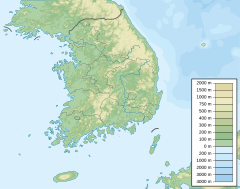Hahoe Folk Village in Andong
 |
|
| UNESCO World Heritage Site | |
|---|---|
| Official name | Historic Villages of Korea: Hahoe and Yangdong |
| Location | South Korea |
| Coordinates | 36°32′17″N 128°31′14″E / 36.5381°N 128.5206°E |
| Criteria | Cultural: (iii), (iv) |
| Reference | 1324-001 |
| Inscription | 2010 (34th Session) |
| Korean name | |
| Hangul | |
| Hanja | 마을 |
| Revised Romanization | Andong Hahoe Ma-eul |
| McCune–Reischauer | Andong Hahoe Maŭl |
| Website | www |
|
[]
|
|
The Hahoe Folk Village (Korean: 안동하회마을) is a traditional village from the Joseon Dynasty. The 'Ha' is short for river and 'hoe' means to 'turn around, return, come back." The village is a valuable part of Korean culture because it preserves Joseon period-style architecture, folk traditions, valuable books, and an old tradition of clan-based villages.
The village is located in Andong, Gyeongsangbuk-do. To the north of the village is Buyongdae Cliff while Mt. Namsan lies to the south. The village is organized around the geomantic guidelines of pungsu (Korean feng shui) and so the village has the shape of a lotus flower or two interlocking comma shapes.
The village is listed by the South Korean government with UNESCO as a World Heritage Site with Yangdong Folk Village in 2010.
The Ryu (or Yu in some transcriptions) clan of Pungsan established the Hahae Folk Village in the 16th century during the Joseon Dynasty and has been a one-clan community since that time. The village is notable because it has preserved many of its original structures, such as the village Confucian school and other buildings, and maintains folk arts such as the Hahae Mask Dance Drama ('Byeonlsin-gut') which is a shamanist rite honoring the communal spirits of the village.
The village today is divided into Namchon (South Village) and Pukchon (North Village) with the main branch of the Pungsan Ryu clan, the Gyeomampa, in the Namchon side and the secondary branch, the Seoaepa, descended from Ryu Seong-ryong a noted prime minister during the reign of King Seonjo of Joseon in the Bukchon side. The north village contains Yangjindang Manor, designated as Treasure No. 306, and Pikchondaek House, designated Important Folklore Material No. 84. The south village contains Chunghyodang Manor, designated as Treasure No. 414 and Namchondaek House, an Important Folklore Material No. 90. While each branch of the Pungsan Ryu clan used lived in their respective manor homes and sides, today both branches live throughout the village.
...
Wikipedia

